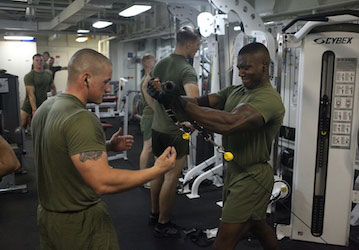What’s the difference between muscular strength and muscular endurance? Muscular strength is the ability of a muscle to exert a maximal or near maximal force against an object—or how much weight you can push, pull, or lift. Muscular endurance is your ability to hold a position for a long time, or push, pull, or lift an object many times. In the military, muscular strength is an important component of physical fitness, especially when you’re lifting artillery rounds, loading and unloading equipment and cargo, or carrying a heavy ruck. In addition, there are things you can do during your workouts to improve your muscular strength and supplement your daily PT.
Building muscular strength can improve your body composition (the ratio between fat and muscle), increases your bone strength, burns calories, and is important for all ages. Some evidence shows low muscular strength is a risk factor for injury, so improving your strength might help reduce your risk.
It’s important to design a workout program that you enjoy and will help you reach your muscular strength goals. If you’re new to strength training on your own, be sure to consult a strength and conditioning professional, USMC Force Fitness Instructor, or Army Master Fitness Trainer for guidance on developing and performing your routine.
Assess your strength
Before starting a program, assess your current level of strength (with a partner for safety) using the 1-repetition maximum or 1RM test to help determine the amount of weight you should be working with. From here, you can design a program that will properly build muscular strength.
 Choosing the right personal trainer Read More
Choosing the right personal trainer Read More
Follow the FITT principle
Although you can use lighter weights to initially build muscular strength, eventually you’ll need to use heavier weights and fewer repetitions than for endurance training. When you’re designing your program, follow the FITT principle—consider the Frequency, Intensity, Time, and Type of your workouts.
Frequency is the number of sessions in a week that you train. You should do strength training at least two days a week.
Intensity is defined by the amount of weight used per repetition. For muscular strength, your training should involve one to 10 repetitions of 60–80% of 1RM per set, and 2–4 sets.
Time of your sessions should range from 30–60 minutes, including proper work:rest ratios. For muscular strength, you should use a work:rest ratio between 1:3 and 1:6. For example, if it takes you 20 seconds to perform a set of 8 reps, you’ll want to rest for somewhere between 60–180 seconds (1–3 minutes) before you begin your next set.
Type of exercise should vary in both your strength and conditioning routines to improve gains and keep you engaged in your workouts.
Progression consists of increasing any one or more of the FITT components. Change your training routine gradually, avoiding large increases in any single component to decrease your risk of injury. Learn more about designing a long-term program and progressing to new goals with a block-periodized workout plan.
Try different types of strength training
Free weights such as barbells or dumbbells are available in most fitness centers and can be purchased at most sports stores. Using free weights for strength training can improve your stability and identify imbalances in strength between your left and right sides. When using free weights, form is critical. Take a look at our tips on foundational movements to learn how to do different types of lifts safely and effectively. The video below shows one of the squat variations, but there are several videos for each of the different movements. If you don’t have easy access to free weights, get creative. Use household items such as milk cartons or bottles filled with rocks, sand, or water. And make sure to add more material as you get stronger.
Machine weights are popular for strength training and typically found in most gyms. These machines isolate certain muscles for each activity the machine is built for. For example, a leg extension machine may help isolate and strengthen your quadriceps muscles. The downside of machines is the strengthening isn’t functional, meaning doing leg extensions won’t be as effective at making you functionally stronger for things like your job duties. When you do use machines, make sure they’re set up properly for your body to optimize the exercise.
Body weight exercises are also great, especially for beginners. These exercises improve stability and strength by using just your body weight (without the use of additional weights) for resistance. Additional equipment such as suspension straps also can supplement and increase the intensity of these types of exercises. However, suspension training might require more skill and instruction if you’ve never done this type of workout before.
Circuit training is aimed at keeping your heart rate elevated while you’re doing short bouts of resistance exercises and battling boredom. Circuit training is typically a combination of cardio and resistance training combined in one quick, efficient workout. You also get the benefits of cardio exercise such as decreased blood pressure and cholesterol levels (which can improve your time on the running portion of your PRT/PFT) plus the benefits of strength training (increased muscle and bone strength and reduced risk for injury). Circuit training is most similar to an actual PT test, with a series of different exercises performed one after the other, sometimes with short rest periods in between.
Use an app to plan and track your strength training
These days, apps for just about any type of workout can show you how to do the exercises and might even have pre-programmed workouts for you to follow. The U.S. Army Training and Doctrine Command’s (TRADOC) “Army PRT” app contains workouts from the PRT workout program. However, keep in mind this might change as the Army shifts from the APFT to the ACFT. Also, visit the Navy Fitness website to find out about the Navy Operational Fitness and Fueling System (NOFFS) program that has several apps for specific training types.
